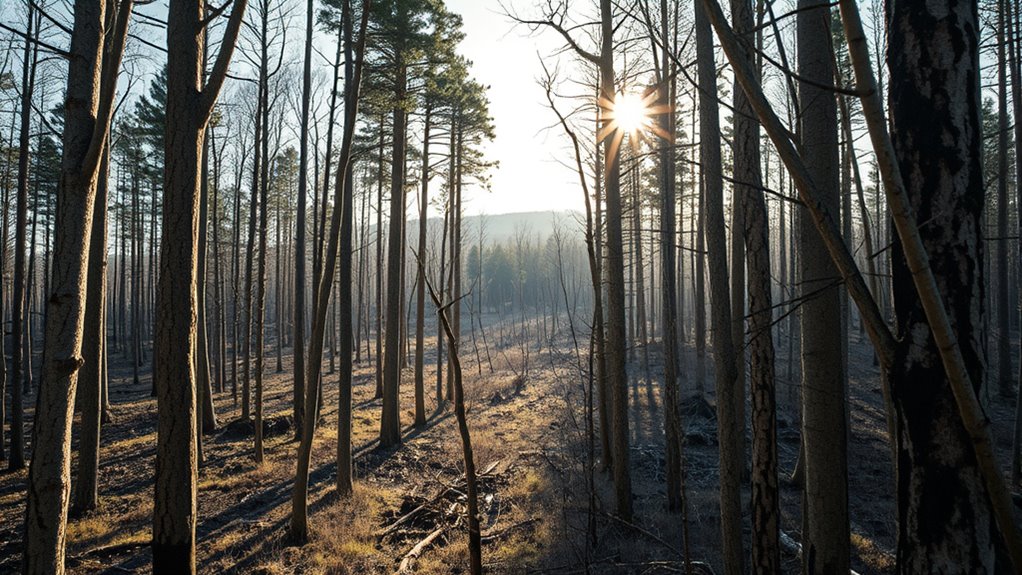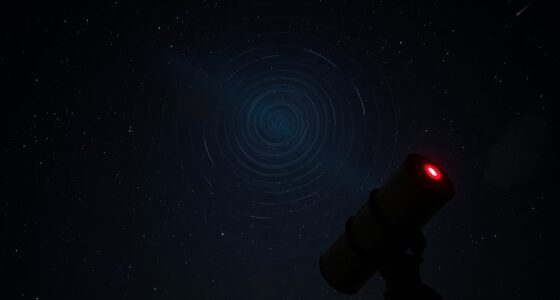Scientists have recently used tree rings to uncover new details about the 1908 Tunguska explosion. By analyzing the growth patterns and stress signals in affected trees, they’ve reconstructed how the shockwave caused long-term environmental damage and estimated the explosion’s strength. This evidence shows that the blast had lasting effects on the local ecosystem, revealing just how powerful the atmospheric event was. Keep exploring to discover more about what these trees tell us.
Key Takeaways
- Tree-ring analysis reveals rapid growth and stress signals corresponding to the 1908 Tunguska event.
- Dendrochronology helps estimate the explosion’s timing and energy release.
- Long-term environmental impacts are detectable through changes in tree growth patterns decades later.
- Recent studies use tree rings to refine understanding of the atmospheric explosion’s effects.
- Evidence from trees confirms the explosion occurred at high altitude, without leaving an impact crater.

On June 30, 1908, a massive explosion erupted over the remote Siberian Tunguska region, leveling an estimated 80 million trees across an area of 830 square miles. This event, known as the Tunguska Blast, is believed to have resulted from a meteor impact that caused an enormous atmospheric explosion. As you explore this historic event, you realize that the explosion wasn’t caused by a traditional impact on the ground but by the intense energy released high in the atmosphere. When the meteoroid entered Earth’s atmosphere at incredible speeds, it compressed and heated the surrounding air, leading to a powerful atmospheric explosion that shattered the meteoroid and released a shockwave. This shockwave radiated outward, knocking down trees and causing widespread destruction without leaving a crater, since the object disintegrated mid-air.
A 1908 Siberian explosion leveled 80 million trees, caused by atmospheric disintegration of a meteoroid high above the ground.
The atmospheric explosion from the meteor impact created a blast wave so strong that it traveled thousands of miles per hour. You can imagine how the shockwave rippled through the Siberian wilderness, toppling trees and destroying everything in its path. The event was so intense that it generated atmospheric effects visible for hundreds of miles, including a bright sky and a powerful sound wave that was heard as far away as England. Despite this dramatic display, no impact crater was found, which initially puzzled scientists. It wasn’t until later that researchers understood the explosion resulted from the disintegration of the meteoroid high in the atmosphere, releasing energy equivalent to several nuclear bombs.
You might be interested in how scientists are still uncovering new clues about this event. Recent studies focus on analyzing tree rings from affected trees, revealing how the explosion affected the local environment over time. These rings show evidence of rapid growth followed by stress periods, indicating the shockwave’s influence on tree biology for decades after the event. The use of dendrochronology, or tree-ring analysis, helps scientists estimate the strength and timing of the atmospheric explosion caused by the meteor impact. This approach provides a clearer picture of how the energy from the explosion traveled through the environment and impacted living organisms. Additionally, tree-ring analysis has been instrumental in reconstructing the event’s timeline and understanding its long-term environmental effects.
Understanding the Tunguska Blast through these new tree-ring findings deepens your appreciation for how dramatic and far-reaching the effects of a meteor impact and atmospheric explosion can be. It’s a reminder that even a relatively small space object can trigger a colossal force upon Earth’s atmosphere, shaping the landscape and environment in ways that are still being unraveled today. The event remains one of the most powerful explosions in recorded history caused by a meteor impact, leaving an enduring mark on Siberia’s wilderness.
Frequently Asked Questions
How Do Tree Rings Record Evidence of Cosmic Events?
You can see cosmic events in tree rings because they act as climate indicators, reflecting environmental changes caused by such phenomena. When a cosmic event like a meteor explosion occurs, it can alter growth patterns in trees, creating distinct rings or anomalies. By analyzing these growth patterns, you can uncover evidence of past cosmic events, as the rings preserve a record of environmental stress or disruptions linked to extraordinary occurrences.
Can Tree Ring Analysis Determine the Blast’S Precise Location?
Pinpointting the precise point of a blast with tree ring analysis is tricky but possible. You focus on distinctive tree ring patterns—such as abrupt growth changes or scars—that indicate explosion effects. While these patterns help with blast localization, pinpointing exact coordinates remains challenging. You can narrow down the general area, but exact location depends on the density and distribution of trees, as well as the clarity of the ring pattern evidence.
What Other Natural Events Can Affect Tree Ring Growth?
You might wonder what other natural events influence tree ring growth. Climate variability, like droughts or temperature shifts, can cause rings to be narrower or wider. Insect infestations also impact growth, as they damage the tree’s ability to absorb nutrients. These factors leave distinct signatures in tree rings, helping you identify past environmental stresses and natural events, apart from extraordinary occurrences like meteor impacts.
How Reliable Are Tree Rings Compared to Other Dating Methods?
Like the compass guiding a sailor, tree rings help you navigate past events, but their reliability depends on calibration accuracy and cross-validation techniques. Compared to radiocarbon dating or dendrochronology, tree rings offer precise yearly data but can be affected by environmental factors. When properly calibrated and validated, they provide dependable chronological records, though combining methods ensures a more thorough understanding of past events.
Could Future Eruptions or Impacts Leave Similar Tree Ring Signatures?
You wonder if future eruptions or impacts could leave similar tree ring signatures. Yes, they could, especially if volcanic ash falls or climate fluctuations cause rapid changes in growth patterns. These events disrupt normal conditions, creating distinct ring anomalies that scientists can detect. While not identical, such signatures can help identify past and future environmental disturbances, allowing you to understand how natural events influence tree growth over time.
Conclusion
In summary, the new tree ring evidence helps you see the Tunguska blast more clearly, almost like discovering a hidden Easter egg in a vintage video game. This discovery rewrites what you thought you knew about the event, showing how powerful and wide-reaching the explosion really was. Just like finding a secret level, these findings add a fresh twist to history, reminding you that even the oldest stories can have new, surprising details waiting to be uncovered.









